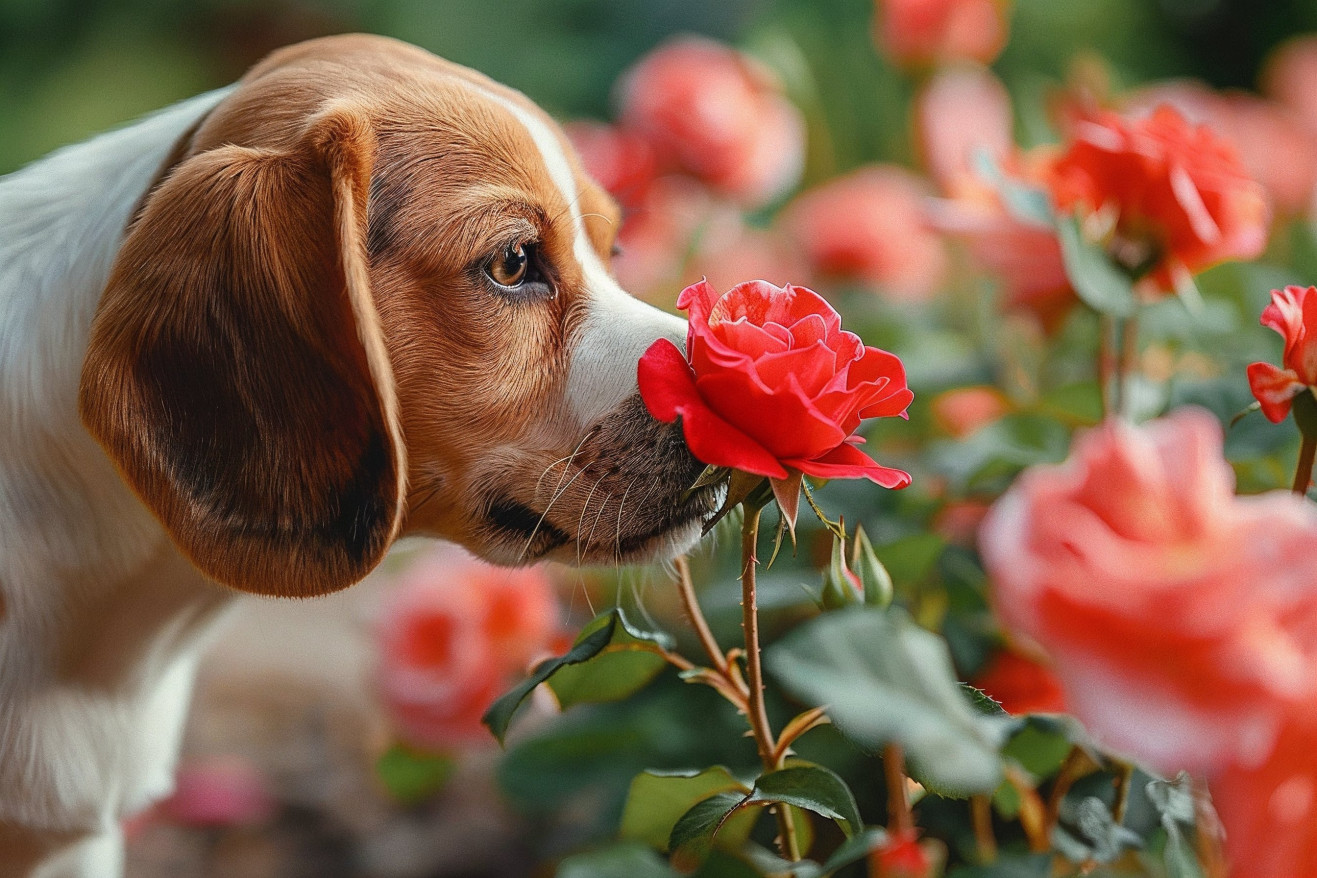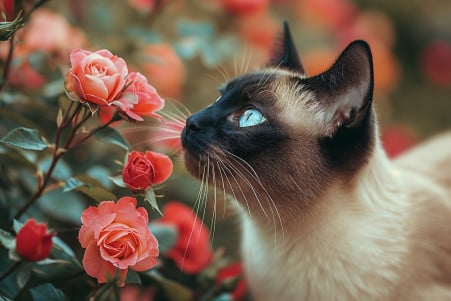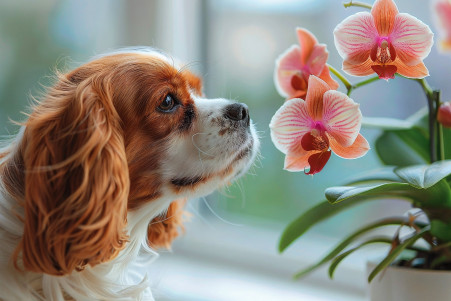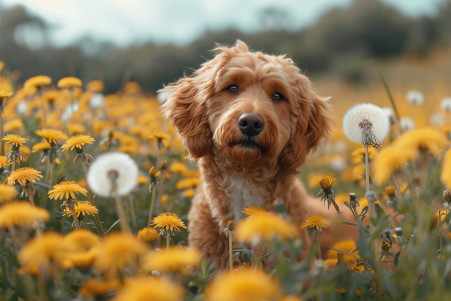Are Roses Toxic to Dogs? Understanding Pet Safety Around Garden Plants
28 February 2024 • Updated 26 February 2024

While roses are often associated with love, are they safe for your dog? Roses are not toxic to dogs, but their thorns can cause physical harm, and the chemicals used to treat roses, such as pesticides, can be toxic. That said, it’s important to always watch your dog for any signs of distress after they come into contact with roses or any other plant.
This article will take a deep dive into veterinary studies, horticultural research, and pet health articles to give you a comprehensive understanding of the topic. We will look at plant toxicity, the potential for thorn-related injuries, and the impact of garden chemicals on dogs. Through these investigations, we hope to give you the information you need to ensure your dog’s safety around roses and other garden plants.
Are roses toxic to dogs?
What Does Rose Toxicity Mean for Dogs?
When it comes to evaluating the safety of plants in your garden for dogs, the word “toxicity” means that a plant has the potential to be poisonous if it is ingested or if it comes into contact with a dog.
In the case of roses, both Dr. Joanna Woodnutt and the Pet Poison Helpline list roses, which are classified by the genus name “Rosa,” as non-toxic to dogs.
This means that roses don’t contain any substances that are known to be toxic or cause a reaction in dogs when they are ingested or when they come into contact with a dog’s skin.
However, the name “rose” can be deceiving. Some plants with the word “rose” in their name, including Moss Rose, Rose of Sharon, and Primrose, are in different botanical families and are not true roses.
In fact, all of these plants can be toxic to dogs, causing everything from mild stomach upset to poisoning, according to the ASPCA.
This is why it’s important for pet parents to make sure they know the botanical names of the plants in their garden to ensure they don’t accidentally expose their pets to something that could be harmful. This is where the distinction between true roses and plants with “rose” in their name becomes important for pet parents to understand.
Risks of Rose Thorns to Dogs
While the actual rose petals are not dangerous to dogs, the thorns are a different story. Thorn injuries can cause a range of physical issues for your dog, from minor scratches to deeper puncture wounds. In some cases, as a vet on JustAnswer explains, thorn injuries can lead to swelling and the development of cysts or abscesses if parts of the thorn are left behind in the skin.
According to Healthline, rose thorns can also introduce bacteria and fungi into the body, leading to infections like sporotrichosis, which is also known as “rose gardener’s disease,” and often requires treatment with antifungal drugs. Additionally, while plant-thorn synovitis is rare and more commonly associated with other plants, it could potentially be caused by rose thorns, leading to inflammation in the joints that may require surgery.
Symptoms of thorn injuries include visible wounds, swelling, or signs of pain and discomfort. If you’re a dog owner, you should start by cleaning any visible wound with a mild soap and water and then watching for signs of infection.
If the symptoms don’t improve or they get worse, you should make sure to take your pet to the vet. They can treat the wound and also help with any potential issues that could arise from the chemicals that the thorn may have carried into the wound.
Chemical Hazards: Pesticides and Fertilizers on Roses
Many gardeners use fertilizers and pesticides to keep their roses healthy and looking their best. Unfortunately, these chemicals can also pose risks to pets that come into contact with treated plants.
For example, the Pet Poison Helpline notes that dogs can suffer from symptoms like vomiting and diarrhea to more serious signs of poisoning if they consume large quantities of certain fertilizers, especially those that contain iron, nitrogen, and other chemicals that can be toxic in high doses.
To keep dogs safe, Today’s Veterinary Practice recommends that pet owners be careful with garden products. While some fertilizers are safe once they’ve dried, the chemicals that are added to them, such as herbicides or pesticides, can be toxic to dogs if they’re ingested.
This is supported by research published in PMC, which found that pesticide exposure at levels that are considered toxic can lead to organ toxicity and even an increased risk of cancer in dogs.
To protect your dog, it’s important to limit their exposure. One way to do this is to opt for natural or pet-friendly fertilizers and pesticides. Not only will this help keep your dog healthy, but it will also help ensure that your garden is a safe place for all of its inhabitants.
By choosing garden products carefully, you can enjoy roses without putting your pets at risk, which will help ensure that your garden is a healthy and thriving ecosystem.
How Roses Compare to Other Garden Plants
In terms of how safe roses are for dogs, they are one of the safer options. However, there are many other garden plants that are much more dangerous than roses.
Dr. Julie Buzby, writing for Dr. Buzby’s ToeGrips for Dogs, explains that plants like Autumn Crocus, Azalea, and Sago Palm are extremely toxic and can lead to serious health problems for dogs. The ASPCA also lists many plants that are toxic to pets, some of which can cause gastrointestinal distress and others that can cause more severe systemic issues.
On the other hand, pet parents can plant a dog-friendly garden with non-toxic plants. Both the ASPCA and Blue Cross recommend flowers like Snapdragons, Petunias, and Sunflowers, all of which are safe for dogs.
Pet parents can make sure their garden is safe for their pets by being selective about the plants they choose. By researching which plants are toxic and which are non-toxic, pet parents can make sure their garden is a safe place for their pets to explore. This way, pet parents can have the best of both worlds, enjoying a beautiful garden while keeping their pets safe.
How to Create a Dog-Friendly Garden: More Than Just Roses
But creating a dog-friendly garden is about more than just the plants. It’s about creating a space that is safe and comfortable for your pets. This means that you should also make sure that the materials you use in your garden are pet-safe. For example, Dachshund Station recommends using cedar mulch instead of cocoa bean or pine needle mulch, which can be toxic to dogs.
In addition to this, many of the problems that can arise from your garden can be avoided if you train your dog to stay out of certain areas and not to eat certain plants.
You should also make sure that you keep up with regular garden maintenance, which includes removing any debris that has fallen from your plants before your dog can eat it.
In an article on petscaping, Pamela T. Hubbard also notes that you should make sure that you are providing your pets with shade, water, and a safe place to play in your garden to make sure that they are happy and healthy in their outdoor space.
Finally, make sure that you are always on the lookout for potential problems. Make sure that you are regularly checking in on your garden to make sure that it is still a safe space for your pets. If you take all of these things into account, you can create a garden that is a beautiful space for plants and a safe space for your pets to enjoy.
Cultivating Balance: Roses & Canine Companions
When it comes to creating a garden that’s not only beautiful but also a safe haven for your furry friend, it’s important to understand the relationship between roses and canine health. The most important thing to know? Roses are not toxic to dogs, which is great news for pet parents who want to enjoy their roses.
However, that doesn’t mean you’re in the clear once your roses have bloomed. You’ll need to be careful and watch for potential thorn injuries and the dangers of chemical exposure from pesticides and fertilizers.
While you can safely plant roses in your garden, it’s also important to make sure you know how to identify real roses and avoid other plants with “rose” in the name that could be dangerous to your dog.
To create a garden that’s safe for your pets, it’s also important to consider more than just the plants you’re putting in the ground. By choosing non-toxic plants, using pet-safe products, and keeping up with garden maintenance, you can create a space that prioritizes both the beauty of nature and the safety of your pets.
As we conclude our exploration of roses and dogs, it’s important to remember that the key to creating a garden that’s both beautiful and safe for your pets is knowledge and care. Your garden can be a demonstration of this, flourishing in both aesthetics and protection, offering a space for you and your dog to appreciate in harmony.


